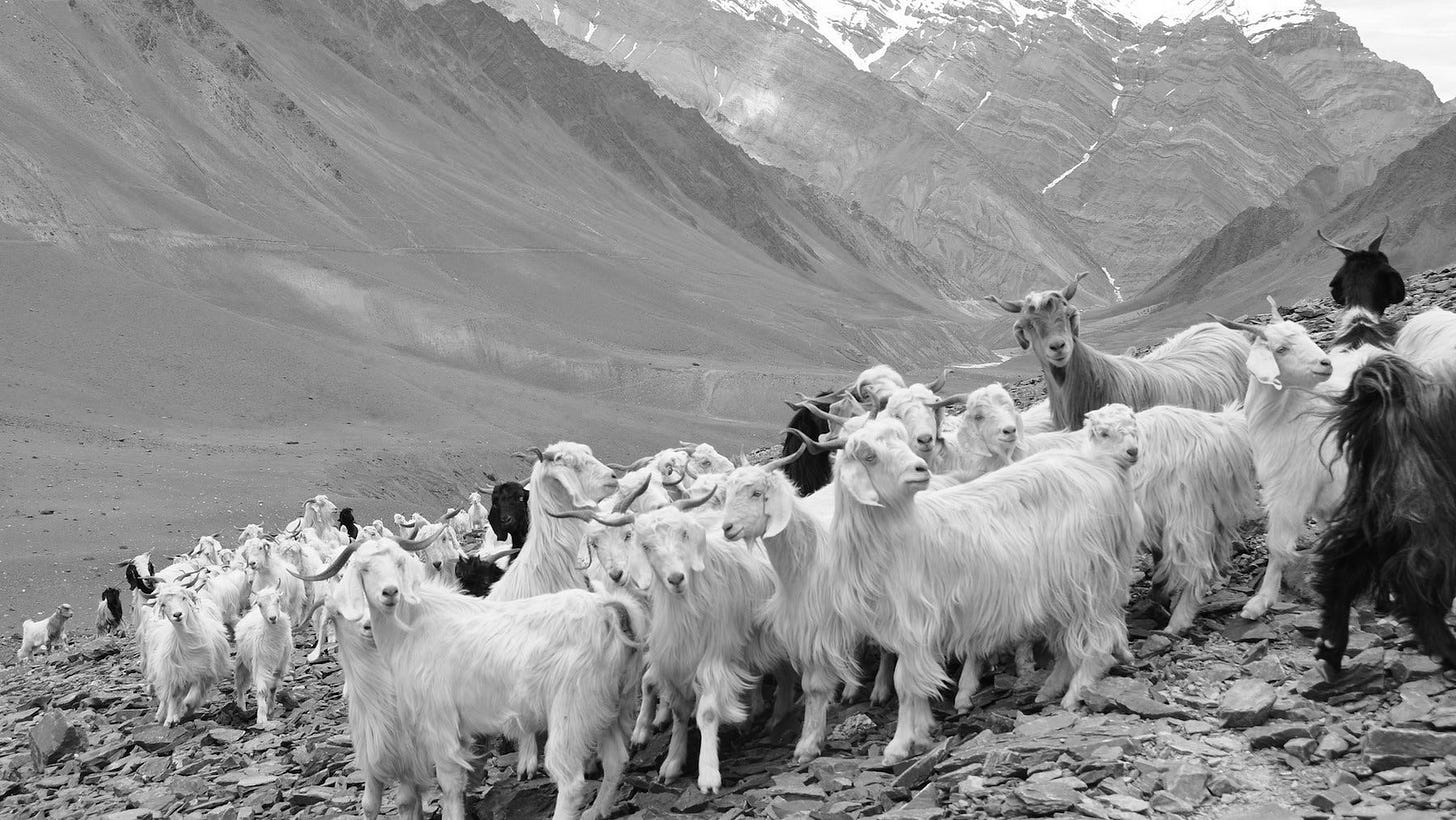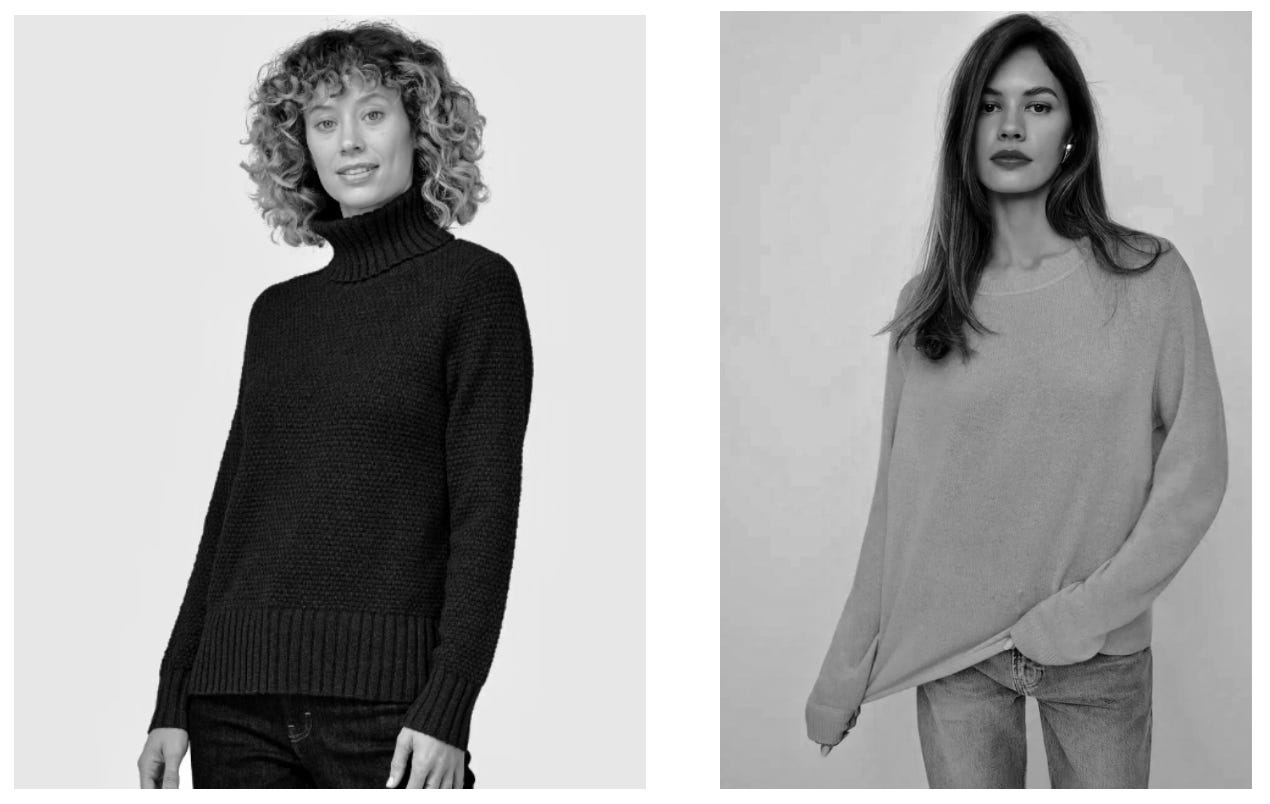
Cashmere is the fine fiber combed from the underside of goats that roam the valleys of the Himalayas. Their long, thin, and strong fiber is perfect for spinning into yarn and transforming into garments. Cashmere is an attainable luxury– most large retailers sell it, and although the price is higher than the average sweater, it can be relatively affordable. But that accessibility comes with ramifications upstream. 70% of all grazing lands in Mongolia, the second largest producer of cashmere, are degraded to some degree, and twelve percent of rivers, and 21% of lakes have dried up entirely.
As consumers expect the luxurious fiber at a relatively affordable price, areas known for their expansive grasslands are becoming deserts. Brands selling cashmere need to pivot, and not just for the sake of their environmental impact. The grazing land for cashmere goats will soon no longer be hospitable for them. Mongolian, Chinese, and Tibetan herders will not be able to continue raising cashmere at the quantities they are now. One solution to the future dearth of cashmere is replacing virgin with recycled fiber.
What is Cashmere Recycling? Recycling cashmere is a process that takes cashmere waste and turns it into fiber that can be spun and woven, or knit into a new garment. The current recycling programs use primarily pre-consumer waste, which is any scraps or unused fiber during the spinning, knitting, and weaving process. Some factories accept post-consumer waste, like used 100% cashmere sweaters. Recycling factories, a majority of which are in Italy, collect the waste from factories all over the globe. Then they hand sort it by quality, wash it, dye it a neutral color, shred it, comb it into individual fibers, and spin the fibers into new yarn.
What Makes Cashmere, Cashmere? Not all the fiber from a cashmere goat qualifies as the cashmere that we use in clothing. Most aggregators of cashmere fiber only accept cashmere that is less than 19 microns, meaning the thickness of the fiber must be thinner than 19 millionths of a meter. The length of the fiber also has to be more than 1.25 inches. This fineness and length allow cashmere to be made into thin yarn and fine sweaters, and give cashmere its signature luxurious, soft feel.
What Changes About Cashmere When It’s Recycled? As a textile known for the quality of its virgin fiber, recycling cashmere, a process that inherently reduces fiber quality, can get a bad rap. The recycling process puts stress on the cashmere fibers. The washing, separating, and combing process breaks the fibers, shortens them, and puts wear on them. The most noticeable difference in the quality of virgin versus recycled is the fiber’s propensity for pilling. Every point where a fiber ends and a new one starts in a yarn or the fiber partially breaks from mechanical processing is an opportunity for the fiber to curl, which causes pilling. With longer fibers, there is less opportunity for the sweater to pill and shed.
Virgin cashmere is an extremely long and fine fiber, and the quality of cashmere being recycled can vary. The fiber diameter can be as small as 12.5 microns. For reference, the finest merino wool is 17 microns. Even with the wear and tear of the recycling process, you will still end up with a fine fiber. Additionally, the fiber length can vary from 1.25in-5in. So if you are recycling 5in cashmere, the result will be similar to shorter staple cashmere. Recycling will never result in the finest cashmere sweater, but cashmere’s exceptional characteristics make it so that there’s potential for the sweater to be great.
How Do You Ensure You are Getting a High Quality Recycled Cashmere Sweater? As a rule of thumb, fine, long-staple fiber makes fine yarn and fine sweaters. Shorter, coarser fibers are more suitable for thicker yarns and chunkier sweaters. A lot of brands try to use recycled cashmere in the same thin, supple designs they used virgin. They may achieve this by adding more twists to the yarn to make the shorter fiber into the same fine yarn. They will also use chemical softeners on coarser yarns to give them a cashmere-like hand feel. Both processes mask the inherent characteristics of the shortened fiber, and with wear, quality and longevity issues will arise.
Recycled cashmere sweaters shouldn’t be exact replicas of virgin cashmere ones. They are made with a raw material that has different characteristics. The best recycled cashmere sweaters look and feel more like wool sweaters because the recycled fiber is more similar in length to virgin wool than virgin cashmere. The highest quality recycled cashmere sweaters are thicker and chunkier than what most consumers associate with cashmere.

The best way to truly understand the quality of a sweater is to wear it over and over again. Comment any recycled cashmere sweaters you have found and loved.
Read last years post about cashmere, here:
APRIL: MONGOLIAN CASHMERE
In April, the days in Mongolia start getting warmer. Before the days get too warm and their animals voluntarily shed their winter coat, Mongolian herders corral their goats and comb out their undercoats. Cashmere goats have a coarser overcoat that protects them year-round and a fine undercoat that they grow in the fall to protect them from the long, col…
NOTES:
https://www.sciencedaily.com/releases/2013/09/130905134026.htm
https://sustainablefibre.org/what-makes-cashmere-cashmere/
https://pmc.ncbi.nlm.nih.gov/articles/PMC7796070/
https://journals.sagepub.com/doi/abs/10.1177/004051750007000216





I have a few recycled cashmere pieces mainly from Italian companies (One Cashmere Forti dei Marmi, Rifò, Artknit) (but I also have a couple from UK brand Raey (RIP)). I love and rate them all. I debobble them periodically but while I found they bobbled a bit on the first wear, it's just regular upkeep since then. I really appreciate the chunkiness - these are very satisfying sweaters to wear on cold winter days!